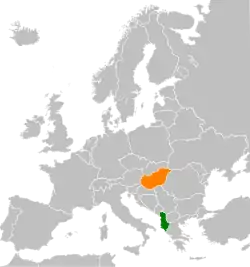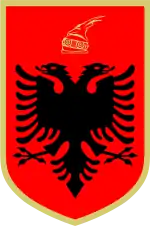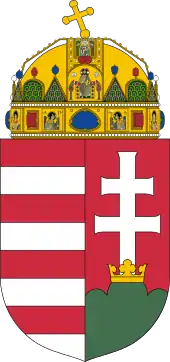Albania–Hungary relations
Albania–Hungary relations refer to the current and historical relations of Albania and Hungary. Albania has an embassy in Budapest and Hungary has an embassy and a consular office in Tirana. The history of diplomatic relations of Albania and Hungary dates back to 1912, when Albania declared its independence on November 28, 1912.
 | |
Albania |
Hungary |
|---|---|
The countries are members of the North Atlantic Treaty Organisation and the Organization for Security and Co-operation in Europe. As a European Union (EU) member, Hungary supports Albania in its euro-integration path.[1][2]
History
Historically, Albanian-Hungarian relations were strong in the Middle Ages due to dynastic ties (common governance by members of the Angevin family in the 14th century followed by the marriage of many other Albanian nobles to Hungarians), religious ties, and common interests, especially the prevention of Venetian domination of the Adriatic coast. Hungary played a significant role in the development and spread of Catholicism in Albania during the 13th to 15th centuries.
Both countries then experienced Ottoman rule, with Hungarians and Albanians allying against the Ottomans at numerous points, famously including the alliance between John Hunyadi and Gjergj Kastrioti Skanderbeg. In the Great Turkish War, Albanian Catholic leaders Pjetër Bogdani and Toma Raspasani rallied Kosovo Albanian Catholics and Muslims to the pro-Austrian cause.[3] After the Great Turkish War, Hungary was absorbed into the Hapsburg domain, while Albanian inhabited regions remained part of the Ottoman Empire and experienced a period of economic and societal breakdown, which saw large numbers of Catholics from Kosovo flee to north to arrive in Budapest,[4][5] and the widespread Islamization due to extremely steep increases in the poll tax by Ottoman authorities as well as instances of forced conversion.[5][6][7][8] Albanian Catholicism survived in the mountainous Northwest of Albania with significant aid from Austro-Hungarian clerics. Austro-Hungarian funded Catholic schools were the only schools where Albanians were able to study in their native language during Ottoman rule, and as a result many of their students would contribute to the emergence of Albanian nationalism, as did some Hungarian intellectuals such as Franz Nopcsa.
Austro-Hungary was a key proponent of Albanian independence and opposed attempts by Slavic nations to dominate Albanian lands. Austro-Hungarian diplomatic assistance was critical for the expulsion of the Serbian and Montenegrin armies from Durrës and Shkodër in 1912. After Albanian independence, King Zog married a Hungarian woman. In the early 20th century, Albania and Hungary shared a situation where large numbers of Albanians and Hungarians resided outside of their respective new borders, and both saw the rise of irredentist movements that aimed to create Greater Hungary and Ethnic Albania, but were obstructed by the relative strength of surrounding countries. During World War II, both countries came under the control of Axis-allied regimes, followed by the domination of Communist parties allied to Moscow. Albanian-Hungarian relations came to a halt after the Soviet-Albanian split, but were resuscitated after the fall of Communism.
Middle Ages
Albanian-Hungarian relations date back to the Middle Ages. Especially after Hungary was converted to Catholicism and northern Albanian rulers increasingly also converted and converted their subjects to Catholicism as well during the High Middle Ages especially after the Fourth Crusade, Hungary often had relationships with Albanian principalities.
Academics such as Muhamet Mala and Edmond Malaj have argued that the foundation of the state of Hungary had far reaching political effects that proved critical for the survival of Albanians despite repeated Slavic invasions. Their domination of the Danube preempted any possibility of large unifying Slavic states in the Balkans, which would have "with certainty" have brought about a "definitive Slavicization of the Balkan", changing the ethnic structure in favor Slavic domination at the expense of the survival of Albanians, Greeks and Romanians.[9]
Albano-Hungarian relations existed in two realms, the secular and the religious. In the religious realm, Hungarian assistance was critical for the growth of Albanian Catholicism. [10]
Catholic relations
Albanian monasteries were constructed with similar architecture to Hungarian and Italian models.[11] Intensive clerical relations began in the 12th century and were first documented in 1177 by Gregori, the prelate of Tivar.[12]
The establishment of Hungarian domination by Bela III over the Dalmatian cities of Split, Zadar and Trogir ultimately caused the promotion of Albanian ecclesiastic structures to direct subordination to Rome, rather than having been dependent on the Dalmatian city of Ragusa, as they were previously. After this point, the dioceses of Ulcinj (Ecclesia Dulcignensis), Shas (Suaciensis), Shkodër-Pult (Scodrensis/Pulatensis), Baleč (Beleacensis), Drivasto (Drivastensis), Deje (Dagnesnsis), and et cetera were reorganized into an "Albanian archbishopric" directly under Rome, as Malaj notes, an important development in the growth of Albanian Catholicism in the Balkans.[13]
Hungary provided a "definitive role" in the development of Albanian Catholicism, because it wished to replace the influence of its rival Ragusa in Albania, which had remained outside the control of the Hungarian crown. With the rise of Serbia under Stefan Dušan and the beginning of Dušan's persecution of Catholics; notably, when the Bishop of Shas was accused of murder by Serbian authorities, he found refuge in Hungary. Hungary would also provide Albanian Catholics with aid in their polemical fight against "schismatics" (such as Bogomils), sending its own Dominican priests to Albania for this purpose. In 1278, Dominican priests convened for a summit in Durrës which resulted in the construction of the first Dominican monastery in Albania, a significant event in the deepening of ties with the Albanian noble Thopia family of Central Albania with the Dominican Order and the growth of the latter in Northern and Central Albania.[14]
Diplomatic relations
Relations between Albania and Hungary became more intensive in the 14th century, during the rule of Albania by Charles of Anjou. After 1308, another Angevin (Anzhu as Albanians call the family) ruled Hungary and Croatia as Angevins also remained on the Albanian throne, bringing the three nations into a period of political convergence.[15]
Ottoman conquest
During the Ottoman conquests of the Balkans, Albanian national hero Skanderbeg and Hungarian national hero John Hunyadi were aligned together against the Ottoman Army.
Late Ottoman era
As a unified state, Austro-Hungary helped provide education to Northern Albanians, especially those of Catholic faith, by helping build schools in the vicinity of Shkodër. Unlike all other schools in the country at the time, it allowed students to learn in Albanian. The expansion of Albanian education helped the stimulate the Albanian National Awakening.
A Hungarian noble Franz Nopcsa was influential in the emerging field of Albanology which fueled the rise of Albanian nationalism, and he gave his support to Albanian independence.
Austro-Hungary supported Albanian aspirations, particularly against Serbian claims to Albanian territory, motivated by a desire to restrain the power of Pan-Slavism under the aegis of the Russian Empire, which was a particular threat to Hungary which had to contend with Slovak nationalism, Croatian nationalism and Serbian nationalism.
Communist era
During the Soviet era, both countries were part of the Eastern Bloc and COMECON until Albania's withdrawal in 1961.
See also
References
- "Berisha-Kover: PS, jo bojkot". top-channel.tv (in Albanian). 20 March 2012.
- "SZIJJÁRTÓ: HUNGARY FIRMLY SUPPORTS ALBANIA IN EU INTEGRATION EFFORTS". dailynewshungary.com. 19 November 2016.
- Malcolm, Noel (1998). Kosovo: a short history. Macmillan. p. 162. ISBN 978-0-333-66612-8. Retrieved 21 June 2011.
- Malcolm, Noel (1998). Kosovo: a short history. Macmillan. p. 162. ISBN 978-0-333-66612-8. Retrieved 21 June 2011.
- Pahumi, Nevila (2007). "The Consolidation of Albanian Nationalism". Page 18: "The pasha of Ipek forcibly removed Catholic inhabitants of northern Albania into the plains of southern Serbia after a failed Serb revolt in 1689 and the flight of many Serbs to the Habsburg Empire. The transferred villagers were forced to convert over to Islam."
- Marmullaku, ‘’Albania and the Albanians’’. London: C. Hurst & co., 1975. Page 16.
- Jelavich, Barbara. ‘’History of the Balkans.’’ Cambridge: Cambridge University Press, 1983. Pages 80–81.
- Zhelyazkova, Antonina. ‘’Albanian Identities’’. Page 22
- Malaj, Edmond. Rreth marredhenieve ndermjet shqiptareve dhe hungarezeve gjate mesjetes. Page 272-273
- Malaj, Edmond. Rreth marrëdhënieve ndërmjet shqiptarëve dhe hungarezëve gjatë Mesjetës. Page 268
- Malaj, Edmond. Rreth marrëdhënieve ndërmjet shqiptarëve dhe hungarezëve gjatë Mesjetës. Page 268
- Malaj, 270
- Malaj, Page 270
- Malaj, pages 271-272
- Malaj, Edmond. Rreth marredhenieve ndermjet shqiptareve dhe hungarezeve gjate mesjetes. Page 273

